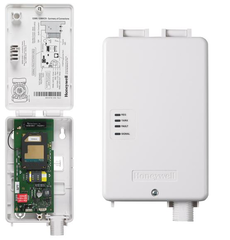Setting the House Alarm Before Leaving
Posted By Michael GorisFor a security system owner, remembering to properly arm the system before leaving can be a tough task. It's one of those little things that's easy forget. You forget to grab your your car keys. You leave a door unlocked. You accidentally leave the lights on overnight. These things happen.

Another concern we often hear from customers is whether or not they really need to arm their systems if they are just stepping outside for a minute. Maybe they're just taking their dog around the block, or visiting a neighbor across the street, or walking over to a nearby convenience store. They will only be gone for a minute or two. Is it okay to leave the system disarmed in these situations?
Obviously, if you leave your system disarmed while you are away and an intruder decides to make a quick break-in, there is little that can be done. Security cameras can capture the event happening, but they aren't going to trigger an emergency response if your system is disarmed. If your system isn't ready to trigger an alarm, and you aren't around to stop an intruder, then there is very little that can be done.
With that in mind, we at Alarm Grid recommend that you always arm your system before heading out, even if it's only going to be for a brief moment. You invest into your security system for a reason. Don't let it go to waste. Protect your belongings and your property. Take the extra second or two and arm your system.
Of course, that is just our advice to you as a monitoring company. We totally understand that some users are going that have that "ah, I'll only be gone a second" mentality. And that's up to you. As an end user, you are in complete control, and if you are comfortable leaving your system disarmed when stepping out for a brief moment, then that is up to you. Just understand that we are not liable if you forget or decide not to arm your home alarm system.
One thing you might do is consider your own personal situation. Maybe it's okay to leave your system disarmed if you're just over at the neighbors, and you can visibly see your house? Maybe you can bring your Android or iOS Phone with you and arm using Total Connect 2.0 or Alarm.com if it turns out you're going to be away longer than you thought? Maybe your can add a key fob to your system to make it easier to quickly arm when walking out the door, instead of needing to enter a code or pull up a mobile app.
Ultimately, how you use your system is up to you. We recommend always arming, even if you're only going to be gone for a little bit. It's not worth the risk to your property, and securely arming/disarming your system can be such a quick and easy task if you add the right equipment. Nearly every alarm panel can be set up with some type of one-touch arming and disarming function to make the process as simple as possible.
We also understand that some users might have the intention of always arming, but they simply forget to do so. We have some tips for these users as well. You might have a secondary keypad right by the door that you will always see when walking out. That way, you will always remember to arm your system. If you don't want to add a new keypad, you could just put a sticky note on the door to remind you. And if your system is monitored, then you can set up geofencing arming reminders through an interactive service like Total Connect 2.0 or Alarm.com. There are many options available.
Remember that many wireless security systems today also often serve as automation controllers. This way, you can use an app on your phone to control the various devices around your home from anywhere. If you forget to turn off your lights, leave your thermostat running, or leave your door unlocked, then you can control the affected device while you are away. This is great for anyone who might be a little absentminded from time to time! Plus, it's good to know that you can always lock/unlock your door or turn your lights ON or OFF if needed. You just need the proper equipment.
Our job is to provide you with reliable monitoring service and the equipment you need to stay protected and secure. You just need to make sure you arm your system when leaving your home. If you need any more tips for remembering to arm your system, or if you want to learn more about any of our products or services that may make it easier for your to use your system, just reach out to us by emailing support@alarmgrid.com. We operate support hours from 9am to 8pm ET M-F, and we are happy to help you out. We look forward to hearing from you!






 Anyone with a personal phone most likely deals with unwanted incoming spam phone calls, also referred to as "robo calls". This is unfortunately something that Criticom has to manage as well. Unwanted spam calls to a central station represent a true life-safety issue. These incoming calls prevent central station operators from addressing serious alarms and life-threatening emergencies as quickly as possible. Fortunately, CMS has taken steps to address this issue.
Anyone with a personal phone most likely deals with unwanted incoming spam phone calls, also referred to as "robo calls". This is unfortunately something that Criticom has to manage as well. Unwanted spam calls to a central station represent a true life-safety issue. These incoming calls prevent central station operators from addressing serious alarms and life-threatening emergencies as quickly as possible. Fortunately, CMS has taken steps to address this issue.